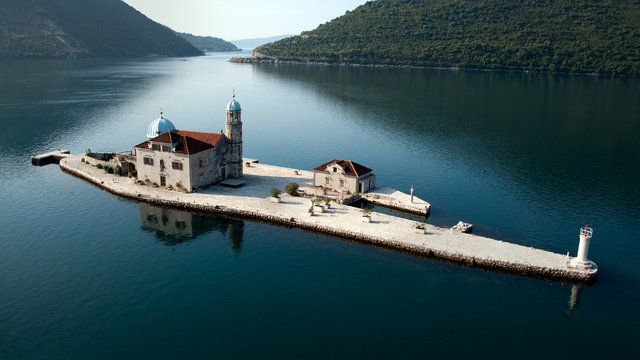Coordinates on the yacht chart plotter: 42°28.979'N | 18°41.339'E
Perast - Shoot the cock
Perast is the city from the picture. The city almost did not change its appearance from the XVIII century. Look carefully - there is not a single modern building in Perast (I confess one thing is - it's the building of an abandoned garment factory built in Yugoslavian times - but it's not very conspicuous). Modern construction in the city is prohibited; it is an attempt to save the city its original appearance. Funny detail - the inhabitants of the city cannot, like all normal people, patch up a hole in the roof, buying a new roof tile - it will contrast with the roofs of the city, and they are looking for where the old and burnt out.
The history of the medieval city dates back to the XV century, when the inhabitants of Perast, showing intelligence, decided to engage in brokering trade. In the XV century, they descended from Mount St. Elijah, where they were engaged in viticulture, to its foot and began to learn how to build ships. In the Middle Ages, people were very little interested in sunbathing and bathing, trying to survive, they went up to the mountains to the sources of water and food. But not to draw attention from its mountain to the scurrying ships right under their nose, enriching the inhabitants of Kotor, was also impossible.
The inhabitants of Perast had no goods and money - they had to borrow from aristocrats of the same Kotor and Dubrovnik. Fortunately, the trade went smoothly. On small, light maneuverable vessels, the townspeople made their way to the trading cities of Greece, Italy, Dalmatia or Albania and, having escaped from pirate Turkish ships, returned safely to Bay of Kotor. And the debts were returned, and there was enough for life. In the XV century captains of Perast began the erection of their palaces directly on the seashore, at the foot of Mount Elias.

In the same century, the Republic of Venice became interested in Perast, which just picked up the Kotor Bay and a large part of the Adriatic coast. It turned out that the city is in a strategically important place - and therefore, it must become a guard of the sea route, which leads directly to Kotor, the main outpost of Venice in the Bay of Kotor. So very soon the city will be awarded the title of "frontier" (meaning the boundary between the possessions of the Venetians and ever increasing Turkish possessions), and most importantly - will become the custodian of the Venetian military flag. Three hundred years later - after Venice falls - inhabitants of Perast will hold a solemnly-sad ceremony of the funeral of the flag under the altar of the main city church - the church of St. Nicholas.
The Venetians rewarded the residents with knowledge, but they did not give money to build the fortress wall. They had to extricate themselves. Each captain, who built himself a new palace, attached to it a watchtower. It turned out, and the family in the palace and the city benefit. Well, on top of the building plan over the city, they planted the fortress of the Holy Cross. Nowadays only the ruins remain from the fortress, and from the towers only memories - when in the beginning of the XX century a road was built around the Bay of Kotor, everything that was interfering on the way was demolished. By the way, it was then that the main principle of construction in the Bay of Kotor was destroyed - there were very few people who used roads in former times, everyone moved around on ships and had to be able to stick to their own house, unload their goods and embrace their wives. Stone ledges along the embankment of Perast - is all that remains of the medieval private moorings. Now they arrange restaurant tables and beach chaise lounges.
The glory of the captains of Perast rattled throughout the Mediterranean Sea. Marco Martinovic is one of those captains to whom the cadets from Peter I arrived for training. Their names are written by an unknown artist in the picture, where almost everyone is on the same person - and Marko Martinovic, and the nobles are gloomy men with long hanging mustaches.
Next door, on the another canvas - another captain - Matia Zmaevich, a man whose life deserves a long time writing an adventurous novel. Prisoned in Constantinople for a fight and recovered from there by the same Peter I, Matia Zmaevich arrived in Petersburg. For several years of service, Matia passed from the captain of the first rank to the commander of the galley fleet, the chief commander of the St. Petersburg port and the admiral of the Russian Empire. By the way, in the lists of Russian admirals it can be found under the name of Matvey Khristoforovich, that's how he was called in Russia.
These paintings can be seen in the naval museum of Perast. The diaries of the first earl of the glorious Tolstoy dynasty, Pyotr Andreevich, are kept under the windows of the store windows, looking after the noblemen for training and bothering for Matii Zmayevich before Peter; the reading and writing of Peter the Great and the St. Andrew's flag.

Every year on the 15th of May, under the 55-meter bell tower of St. Nicholas Church (the highest in this part of the Adriatic), Perast becomes crowded. On this day, a very special holiday is celebrated in the city. "Gadzhene kokot" - "shoot the cock".
Several centuries ago, in 1654 Perast was attacked by Ottoman Turks. According to the legends, the Turks were several thousand, and the inhabitants of Perast were less than a hundred. It is believed with difficulty, but the city was defended. In memory of that bloody battle, every year on May 15, at sea on a foam plastic platform, a bright, screaming bird is portrayed, symbolizing the hated world of the Ottoman Empire. Young men of the city line up on the quay, holding in their hands replicas of old muskets and in turn shoot at the cock. Whoever gets - is considered the hero of the holiday, he is poured a full bowl of Vranac (the local wine). Well, after the solemn procession with icons and banners is held around the city.
Centuries replaced each other, the steam engine quietly superseded sailing ships, stories of battles and captains became legends. Today, the cruise liners past medieval palaces and from the upper decks of which the city seems like a pretty theatrical setting, built specifically to decorate the bay and meetings of seafarers.











